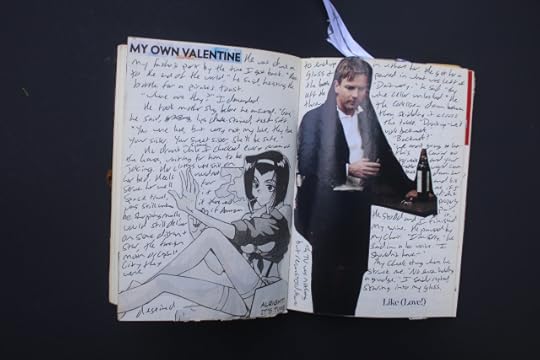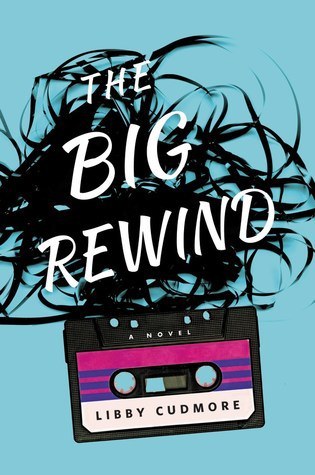Libby Cudmore's Blog, page 5
August 27, 2015
De-Stem Your Prose: Writing Advice from SIDEWAYS
“They didn’t de-stem, hoping for some semblance of concentration, crushed it up with leaves and mice, and then wound up with this rancid tar and turpentine bullshit.” Miles (Paul Giamatti) Sideways.
This is my favorite way to describe over-wrought prose. Back in college, writing “leaves and sticks and mice” in the margins was a shorthand among my friends to cool it on the adverbs and get back to the action. Too many writers use miles and miles of description to give their story some semblance of depth, when in reality, the character has spent the first three pages getting dressed. Yes, description is important, but leaves and sticks and mice do not good wine make.
(A variation on this comes via Nick Mamatas, genius; “I’ve seen more first pages ruined by socks and coffee than I care to count.”)
Description is tough. Too little and your action takes place in a black box. Too much and it weighs down the story. Description is the guitar solo of writing — too much, and your audience will just get bored:
Nick’s great advice boils down to this — if it’s something everybody does on a regular basis, you don’t need to describe it at great length. You don’t need eight words to describe a tree, or the Keurig or putting a CD into your car’s CD player. Your reader will trust that, by the very nature of your character being present, that he/she woke up, put on their socks and arrived at this location. It’s about picking the details that are crucial to the story. If the tree suddenly has a dead body hanging from it, that’s important — otherwise, it’s just a tree, who cares? If the protagonist has a cup of coffee and it tastes off because her lover poisoned it, by all means, show her getting that cup of coffee.
But useless details clutter up the prose. It isn’t world-building if the words lie thick and flat on the page. The key to description is this — how does your protagonist interact with the world? Miles’ description of the wine is a) action-oriented; it’s in dialogue and b) illustrates the difference between this swill and his beloved pinot noir.* He’s interacting with the world, explaining it to the uninitiated (Jack).
Ask yourself this: Does my protagonist already know this scene? Is this a building he walks by every day and if so, why would he make note of it today? Chances are, he wouldn’t — and if that’s the case, it’s a pretty good indicator that your prose is full of leaves and sticks and mice. But if there’s a sudden new door on the building, or a dead body on the steps, or even some graffiti, it gives your protagonist a chance to interact with the world that you’ve created for him.
*Obligatory


August 13, 2015
How To Not Be a Stressed-Out Monster
After a couple weeks of crushing chest pains and stabbing feelings in random parts of my stomach, I managed to get a doctor’s appointment, where they did a bunch of tests (including an EKG) and determined that I have an ulcer brought on by the debilitating stress that is my everyday existence.
A little background on me. I am and always have been an anxious person. I fight it pretty much all the time, but it manifests in weird ways, like waking up in the middle of the night convinced that I reported Common Council voting “yes” when they really voted “no” and my headline will be wrong and everyone will hate me. Even after I have double and triple checked, it still keeps me up at night.
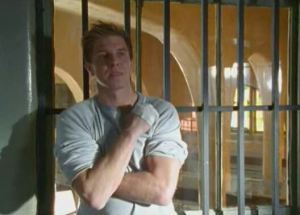
#ShieldLife
Couple that general anxiety with editing a book and planning a wedding, and, well, you wind up with an ulcer. I named mine “Lem.”
Don’t get me wrong — I love my job and my book is awesome and my wedding was magical, but these things are stressful and I internalize stress. My doctor wrote me a prescription, which included “relaxing activities — music, walking or scrapbooking.”
Well, I wasn’t going to take up scrapbooking, but I did dig out a whole bunch of craft stuff — including cross-stitch, sewing and knitting — to help sooth my nervous soul. When I can’t write, I turn to crafting as a way to keep myself creative.
I love sewing. I made/altered a lot of my own clothes in high school, spurred on by DIY articles in Seventeen and YM. I’m not the greatest at it, but I can smoothly stitch a salvaged t-shirt graphic onto a new tank top, as I did with both my well-worn Siouxsie and the Banshees and Alamo Drafthouse shirts. I also made a case for my new kindle, out of the sleeve of an old leopard-print jacket.
This addresses my stress two-fold: 1) It’s a relaxing activity and 2) It helps me de-clutter. I love that jacket, but never wore it. Now, I get to keep a fabric that I love, with new usefulness. My friend Mike was teasing me about being “productive” when I was supposed to be relaxing and recommended his regiment of video games and binge-watching. Works for him, not for me. Because I didn’t see it as being “productive.” Yes, I got a couple new additions to my wardrobe (perfect for my upcoming honeymoon!) but more importantly, it was time I spent for me and for no one else. I wasn’t on anyone’s schedule, what I created was just for me.
And it WORKED. One day in and already I feel more relaxed, fewer pains, the ache in my chest is only at about 50%…and I haven’t even filled my prescription yet!


August 12, 2015
On Triathlons and The Myth of ‘Wasted Words’
 One of the coolest parts about my job as a reporter is that for all the meetings I attend and hard news I write, I also get to do a whole host of feature stories, which means I get to meet a lot of interesting people. And last week, once again, I got to dip into my email and pull up Olympic triathlete Sarah True’s (formally Groff) contact and email her congratulating her on qualifying for the 2016 Summer Games in Rio.
One of the coolest parts about my job as a reporter is that for all the meetings I attend and hard news I write, I also get to do a whole host of feature stories, which means I get to meet a lot of interesting people. And last week, once again, I got to dip into my email and pull up Olympic triathlete Sarah True’s (formally Groff) contact and email her congratulating her on qualifying for the 2016 Summer Games in Rio.
Sarah, like her sister Lauren ( NYT bestselling author of Monsters of Templeton and the forthcoming Fates and Furies) are Cooperstown natives, so whenever they do something awesome — which is seemingly all the time — I get in touch and write a story.
And as I looked through photos of the qualifying race, I thought about what it takes to compete in a triathlon. I ride my bike into town to get coffee, sure, and I can run to catch a bus pulling away from the curb, maybe swim a little in a hotel pool when I’m on vacation, so seeing someone like Sarah kicking ass on the course just blows my mind. And she got there by practicing her butt off, swimming Otsego Lake as a teenager, and getting up every day to ride and run and swim some more. You don’t get to the Olympics twice by playing video games and eating chips all day.
A good writer should follow a similar regiment of practice and persistence. I generally advocate writing every day (I’m lucky in that I’m a professional writer so I’m able to do this, although sometimes it’s Oneonta City Hall rather than The Big Rewind‘s Brooklyn). Every sentence you write makes you a better writer than you were the day before.
I was recently talking to a friend who’s just getting back into writing. He was struggling with his new story, and I suggested that he go to a conference or take a refresher course to inspire him. I even gave him some writing exercises that might help him flesh out his characters and streamline his plot. He adamantly refused, saying that he “didn’t have time” to “waste” on pages he was “just going to throw out.”
And I thought about Sarah and the miles she runs/swims/bikes every day. Are those wasted miles because there isn’t a podium waiting at the end of the course? Of course not, don’t be dense. How is putting words on a page any different?
And sure, no one likes to spend an hour at their desk, only to realize that what they’ve written doesn’t work for the story. I ended up scrapping more than one scene in The Big Rewind. I got rid of lines I was in love with and combined characters for ease of reading. But even if you scribble it out, tear out the page, erase the paragraph or delete the whole scene, those words aren’t wasted. They’re not wasted because they helped strengthen you as a writer.
I recently found half a novel I’d written over two journals during my post-college year in NYC. It was exactly the kind of vomitous, self-indulgent prose that all 22 year old creative writing majors churn out, but what I noticed the more I read, the more I saw the threads of the character (then named Lucille) who would become Jett Bennett, the protagonist of The Big Rewind.
I didn’t make any money/publication credits on that novel. Hell, I never finished it. By my friend’s approximation, those were wasted words. Except they weren’t, because they were sketches — even if I didn’t know it at the time — for a book that would eventually get published. I borrowed the character Sid from another story I never sold, and supporting characters Mac and Reese from other, smaller pieces that never quite had their due. Like an Indian using all parts of the buffalo, I salvaged what I could from what I had. Nothing was wasted.
There are plenty of ways to be idle: TV, video games, Netflix binges, Facebook, Buzzfeed quizzes. But writing, creating, is never a waste of time.
No one ever got worse by steady practice.
Only by inactivity.


August 8, 2015
Keeping a Notebook Pt. 2
Let me introduce you to my papercraft creations:
The Book of Crows: My first! The spine is a mess, but it’s still got a cool look to it. I went a little crazy in the papercraft section of Michaels, hence the knob on the front cover. HOWEVER, the knob makes it impossible to lay the book flat, which is a mistake I won’t make again. I use this notebook for writing weird fantasy stories, and thus it is filled with skeleton stickers and cut-out panels from The Goon. This one also has a built-in bookmark, which is its own lovely little piece of artwork.

The Book of Crows

The Book of Crows — Interior
Gail: Named for the machine-gun toting hooker-queen in Sin City, this is my crime-writing notebook. I think the “Fuck Poems” sticker came from AWP. This was my first successful coptic stitch, although the cover is a bit loose. I salvaged an old sketchbook for the signatures, so several pages are water-stained, which lends it a certain authenticity for a crime-writing journal. Currently I’ve got the starts of two novels in this book, so we’ll see which one takes top priority.
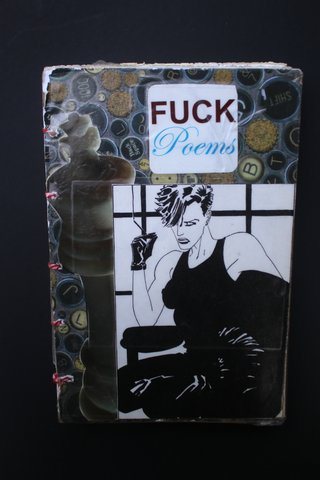
Gail
Dutch: Dutch is my all-purpose go-to notebook. I can do anything in this notebook. The cover is made from a box of “King Dons” – Canadian Ding-Dongs – that my sweet friend Juanita sent me, which explains why this notebook is named for Dutch Wagenbach. Also it’s a workhorse and it takes a lot of abuse, plus there’s a tag that Ian made me that says “Stay Away From Me, and Stay Away From My Desk” that I hang over a chair whenever I need some privacy.
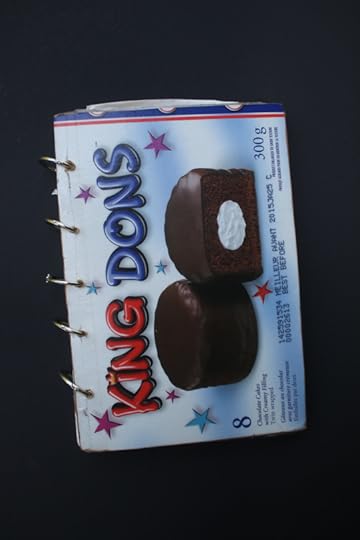
Dutch
I went with an assortment of signatures on this one; papers of various textures, thickness and color, as well as ephemera like postcards and envelopes throughout. The original spine was ribbons, but they were cutting into the paper, so I switched to metal rings instead. Not my favorite way to bind, truthfully.

Dutch–assorted papers
The back inside cover has a collage I made of Lagarto Hombre attacking Toyko. If I could remake this notebook, I might have used that as my cover because it makes me laugh every time I look at it.
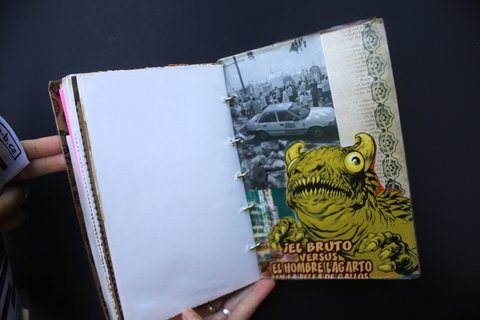
Dutch — Back Cover feat. Lagarto Hombre
Catch: I didn’t make Catch, but it’s a cool-looking notebook just because of all the stuff. Early drafts of The Big Rewind were written in this notebook, as well as stories like “The Redemption of Oren Barry“. This is where I got back into the practice not only of keeping a notebook, but of collaging the pages with ephemera.
I’m testing out a concertina spine on an art-book I call “Drinking Coffee Elsewhere,” made of hotel stationary and vintage postcards, and I’m working on plans for a new go-to notebook when I finish with Dutch (which should be fairly soon; I think I’ve got about 20 pages left).


August 5, 2015
Galley Copies
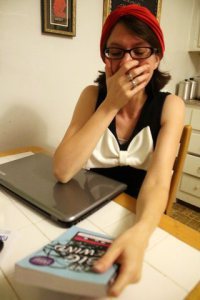 My galley copies of The Big Rewind arrived yesterday and…wow. They’re incredible. To actually hold my own book in my hands, to see my name on a cover is such a thrill that I lack the words to describe it. For the whole night I kept picking it up and turning it over in my hands, thinking this is really happening. That’s my name! On the cover of a book! Those are my words, my sentences, my scenes all laid out in actual, book-like form! Eee! It doesn’t seem real.
My galley copies of The Big Rewind arrived yesterday and…wow. They’re incredible. To actually hold my own book in my hands, to see my name on a cover is such a thrill that I lack the words to describe it. For the whole night I kept picking it up and turning it over in my hands, thinking this is really happening. That’s my name! On the cover of a book! Those are my words, my sentences, my scenes all laid out in actual, book-like form! Eee! It doesn’t seem real.
And yes, I cried when I opened the box.
And the best part is that my husband, Ian, who hasn’t read the book in any form, is devouring it. Not just because I wrote it (he’s very honest which stories of mine he loves and which ones aren’t his thing) but because he’s actually enjoying the book. I had to banish him to the other room last night because I wanted to go to sleep and he couldn’t put it down. That might be the best endorsement I’ve gotten so far!


August 2, 2015
The Big Rewind….Cover Reveal!
Here it is, the cover for my debut novel, The Big Rewind!
I am beyond thrilled about this. I had gone back and forth about it, choosing colors and such, with Chelsey (my editor) & Jim (my agent), who are the two most awesome people in the publishing world, but until now, the cover was still top-secret to my friends and followers.
Then yesterday I got a text from Matthew saying “I saw your cover and it’s AWESOME” and checked Goodreads to see that, yes, my final cover has been released. And it started to hit me that not only is this a book, but that people actually want to read it. ARCs are going out to reviewers and reviewers are excited about them. I can’t stop smiling, even though I have a crippling migraine that mere existence makes worse.
I am always so surprised when people are excited about my work. I came up in a very negative writing environment, with one teacher telling me I’d never be a writer and other mentors telling me to “stop bragging” when I published a story. I had a grad school mentor sabotage my thesis and the program director shrug it off when I complained that, hey, now I can’t graduate. In high school, despite being sent to several young writer’s conferences, including the exclusive statewide Silver Bay conference (where I met my pal April, who I adore) the school’s Creative Writing scholarship went to a student who’d never attended a single one.
(Generally I refer to my ex as a complete cad, but I will give him this — he fully supported me as a writer, giving me the summer I lived with him to write all day, rather than insist that I get some 3-month job before I went back to college. I never published the book I wrote (because it was garbage) but for that patronage, Aaron, I will always be appreciative)
So while I never stopped writing, I partially absorbed this idea that my work was worthless and that no one cared. I can take rejections — hell, I got three this week — but being told by mentors that other students didn’t like me because I published so much* is kind of a drag. Whenever the words won’t come, I panic that, oh bollocks, they were right and I really am just a fraud.
But the fact that people are marking The Big Rewind on their Goodreads “To-Read” list? That I’m having stories solicited by lit mags and anthologies? All this makes that garbage go away. It’s a reminder to focus on the positive people in my present and future, rather than all the negative in my past.
*Yes, someone at my grad program actually said this to me.


July 30, 2015
Farewell, PANK
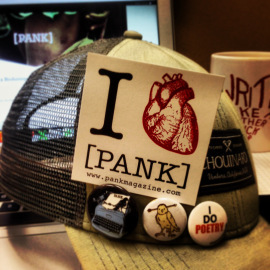
SWAG, BABY!
PANK announced today that they would be closing down at the end of this year. This is a drag on multiple levels. One, they always had the best buttons at AWP and two, because being published by PANK is an awesome experience for any writer. I would know — they picked up my story “Hotel Jesus” in March 2011.
“Hotel Jesus” was one of my turning-point stories where I began to see that I could play with form and format. I allowed myself to explore the narrative voice rather than dictate it. It’s a story driven by language and image, rather than plot, and it allowed me to start looking at characters who exist in the grey areas of morality.
It’s also hopelessly fucking sad, and I can’t remember what sort of terrible nonsense I must have had going on when I wrote it. But I haven’t written anything like it since, which is too bad. It’s a fascinating little piece.
Fare thee well, PANK. You will be much missed.


July 29, 2015
On Keeping a Notebook
I got back into using notebooks a few years ago, when I cracked open a beautiful, untouched leather journal Jason brought me back from Italy as a present for my 23rd birthday. It took a lot to write in that journal because I, like most writers who are gifted with beautiful journals, panic “It has to be perfect if it’s going in such a beautiful journal!”
But I got thinking about the notebooks I kept when I was living in New York City, these wild things filled with magazine clippings and pictures and fold-out pages of articles I wanted to save. I thought about how good it felt to physically write, pen on paper, how much I enjoyed going back through old story notebooks from high school and after college, reading false starts, pithy observations and scenes that didn’t make the final draft. I could trace the what was going on in my life through those notebooks even better than I could my own diary. Fragments like What is a poem to a creme brulee? told me what I was thinking and feeling at an even greater depth than scrawling I love a man who will not tell me he loves me in my journal.
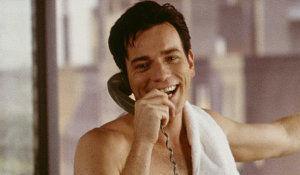
I’d Like To Talk With You About Your Book…
So I wrote one sentence. And then another. And the more I wrote in that notebook — which I nicknamed “Catch” after Ewan McGregor’s playboy in Down With Love— the more I thought about my notebook needs. I loved the freedom of an unlined page. The spine was beginning to crack, so I needed something more flexible. I once had a notebook with an envelope pocket, that was cool.
And as the saying goes, if you want something done, you’ve got to do it yourself.
I began researching how to make notebooks and taught myself coptic stitch. I made a messy first one that I loved anyways. The second was tighter, stronger. I made notebooks for friends. The third I tried to be fancy with ribbon, but ended up going utilitarian with binder rings instead. And I kept designing and sketching new creations, testing and acquiring new materials, plotting and scheming what my next book would look like, what it might represent even before I put the first word on the page.
And with each notebook I created, I felt less and less of that pretty-journal panic and more intimately connected to the page. I began to look forward to opening those notebooks, as though finishing and turning each page had a new surprise in store–a postcard, a new texture of paper, a hidden pocket. I named all my notebooks, the way Tori Amos named her piano, each with their own distinct personality, their own special writing purpose. And tomorrow I’ll introduce you to all of them.


July 26, 2015
BOOK GIVEAWAY UPDATE
I’m packing up writing craft books to ship out Monday, but I still have a few left to give away.
If you’d like one, just find me on Twitter (@libbycudmore) or leave a note in the comments section. US only, please.
Cory Doctorow, Content
The College Handbook of Creative Writing, Third Edition (my favorite)
Writers Digest “HowDunIt” Series, Cause of Death


July 22, 2015
BOOK GIVEAWAY
In the continuing purge of stuff from my father-in-law’s basement, I came across a box of writing craft books from when I was first starting out. I love craft books even though I rarely use them anymore; their pages stuffed with knowledge and promise and possibilities.
But just because I’m not using them doesn’t mean they won’t have value to someone else. So I invite you, dear readers, to find me on Twitter or leave a comment if you see one from the list below that you would like. No charge, no postage; if you want to trade me a book or a mix CD, I probably won’t say no. First come, first serve. The books are:
P.D. James, Talking About Detective Fiction
Cory Doctorow, Content
The College Handbook of Creative Writing, Third Edition (my favorite)
Writers Digest “HowDunIt” Series, Scene of the Crime and Cause of Death
One per person, please, and I’m sure I’ll post more soon.



